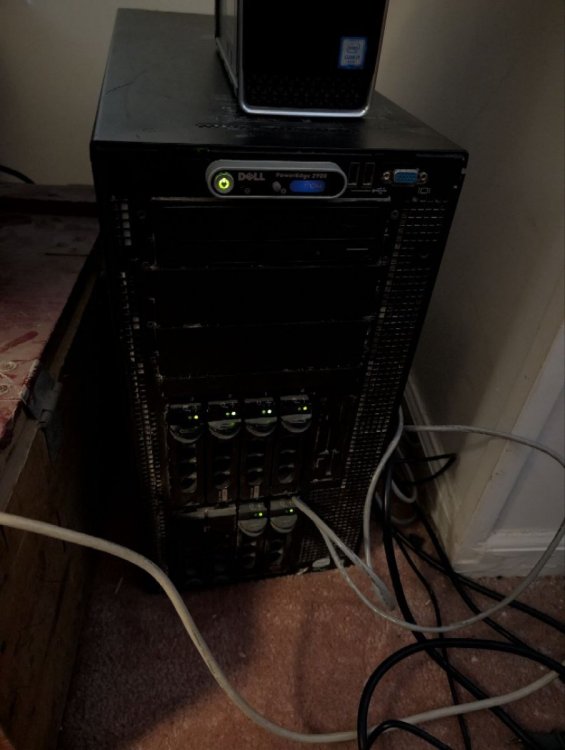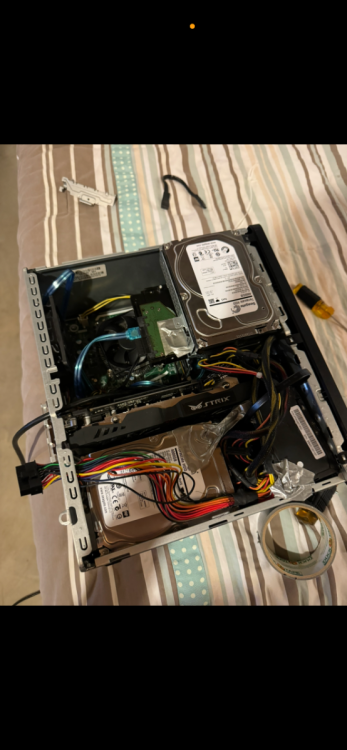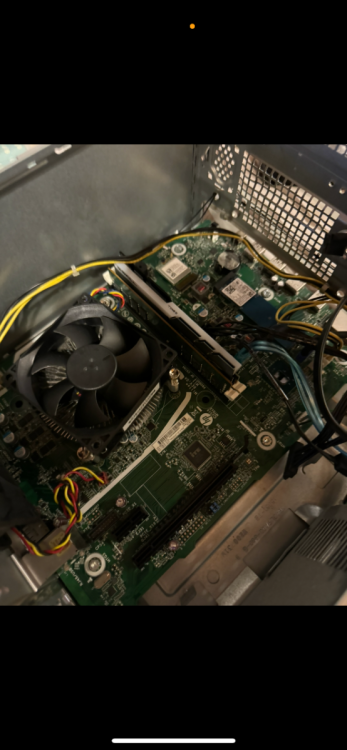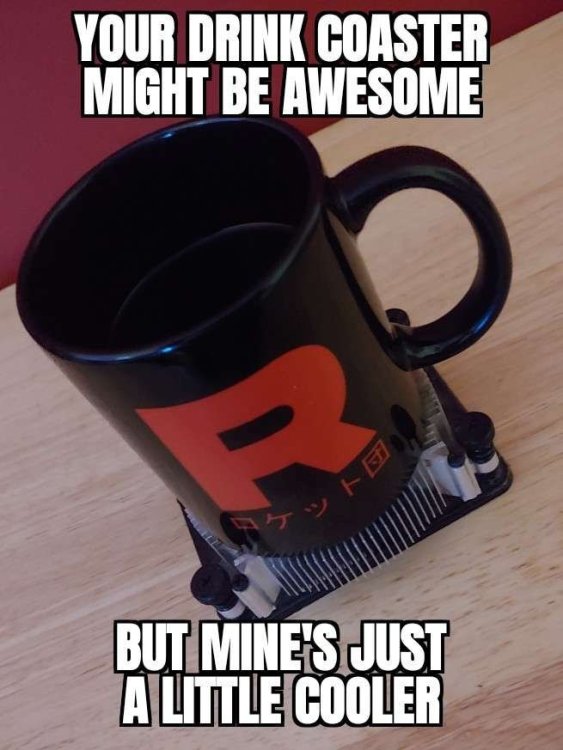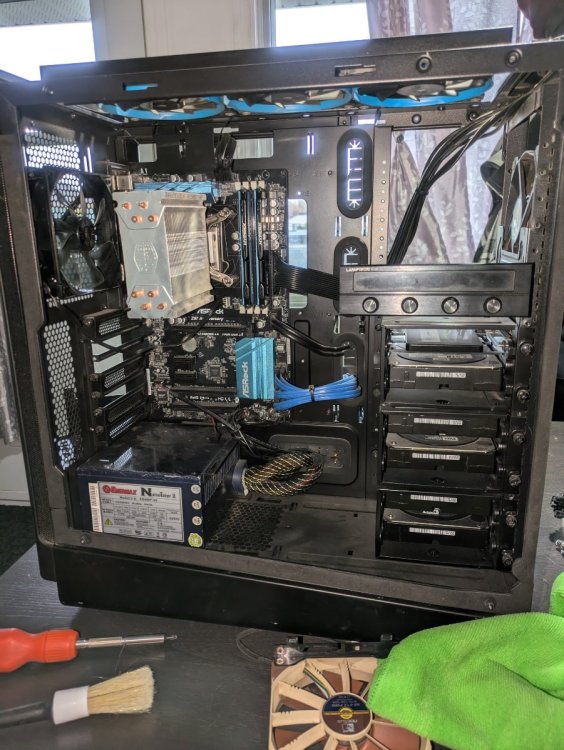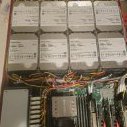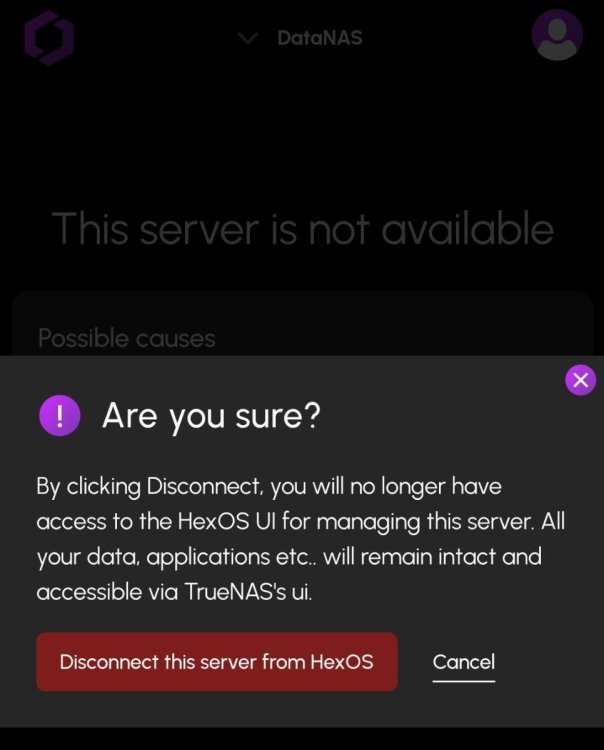Leaderboard
Popular Content
Showing content with the highest reputation on 12/04/24 in all areas
-
UPDATE: As of 11/8, we have updated the ISO installer to run on version 25.04.2.6 of TrueNAS SCALE. Existing users should NOT reinstall to get this version. You can update from within the Activity card on the Dashboard (or the Notification). Hello and thank you for joining the HexOS beta program! You are an elite and vital part of this project and your participation is greatly appreciated. This post contains all the information you will need to get started with HexOS and how to communicate with our team during your beta experience. Disclaimer Beta Products, Software, and any related Services are still in development, and therefore, you are advised to safeguard important data, to use caution, and not to rely in any way on the correct functioning or performance of the products, software, or any related services. Beta Products and Services are provided to you “AS IS”, without any warranty whatsoever. Expectations During your participation in the beta, we expect you to do the obvious: use and test the software. But we also expect you to communicate with us when things don’t go right or if you’re having trouble. Please post feedback and let us know about your experiences, good and bad. That being said, please remember that this is beta software and early access. HexOS has a long and healthy roadmap ahead. Quickstart Guide For those that just want to get started, here’s the TLDR: Download the ISO here: https://downloads.hexos.com/TrueNAS-SCALE-25.04.2.6-HexOS.iso or https://hexos-downloads.sfo3.cdn.digitaloceanspaces.com/TrueNAS-SCALE-25.04.2.6-HexOS.iso (SHA256 Checksum: e8ed99a322affe0969b82b866161a9f6acbc1561e3cc7b2efb2bf120ffe2e856) Use a tool such as Balena Etcher to image a USB flash device with the ISO. Boot your server from the flash device and install the OS to preferably an SSD. When given the option, opt to create the admin password in the installer (do not select the option to "Configure using WebUI"). Remove the flash device and reboot your server when the install is complete. From another device (mobile, tablet, desktop) that is on the same LAN as your server, login to https://deck.hexos.com using your HexOS credentials. Follow the instructions to complete your server configuration. NOTE: As of the 24.10.2.2 build of this ISO, configuring the admin password via the webUI option has been removed from the installer. However, if you select to create an admin password, but then attempt to "cancel" that process, the ISO will proceed with an installation with no admin password set. This is a known bug and the TrueNAS team will be addressing this in a future update to the ISO. Just don't cancel out of creating the admin password in the installer ;-). Hardware Requirements Booting HexOS is designed to support a wide variety of x86 hardware (Intel or AMD). The minimum requirements are a 2-core 64-bit CPU, 8GB of memory, and a 16GB or larger SSD boot device. However, depending on your needs for performance and applications, more resources may be required. Storage Pools Pools are made up of storage devices based on size and type (HDDs vs. SSDs). Storage devices in each pool need to be roughly the same size*. The OS boot device cannot be a part of a pool. Expandable pools require a minimum of 3 devices and can be grown one device at a time. Non-expandable pools can be created with 2 devices. Initial pool width should not exceed 8 devices. Maximum expanded pool width should not exceed 12 devices. At least one storage pool must be created to use HexOS. *In the event of slight variations (e.g. 240GB and 256GB), devices can be grouped, but total capacity for the pool will sacrifice the larger device’s excess storage. Build Recommendations HexOS has been designed so that a relatively modern PC can be easily transformed into a very viable home server. This means using standard HDDs/SSDs and using onboard controllers for storage/networking. However, since we’re based on TrueNAS, our hardware support is actually rather vast. For more detailed hardware recommendations for advanced builds, please refer to the TrueNAS SCALE Hardware Guide. Installing in a VM As HexOS is based on TrueNAS SCALE, it can be installed as a virtual machine as well. While the process should be fairly self-explanatory, please see the TrueNAS SCALE documentation for additional instructions on VM installation. Setup and Configuration Once the OS has been installed and rebooted, you will use a web browser on the same network as your server to register your system and complete the setup process. This can be a PC, tablet, or mobile device. Using a capable browser, login to https://deck.hexos.com. Beta 1 Features Our first release is focused on providing a streamlined user experience for setup and configuration and laying the framework for what’s to come. The main features of Beta 1 include: Setup and configuration wizard Configure your home server in minutes with ease. Analyze system health, with warnings for SMR HDDs. Auto-configure storage pools to safeguard against device failures. Securely manage your server remotely via Command Deck. Storage device management Detect error states and conditions and report through the dashboard Highlight individual storage devices and their respective faults Replace devices from storage pools due to failure or preventative maintenance Expand pools as little as one device at a time Folders and users Create and share folders over your local network. Easily manage permissions for secure access. Apps One-click deploy Immich as a personal photo library app. One-click deploy Plex as a home media server. Automatic folder creation for app storage. Dashboard / UI Access key statistics like CPU, memory, network, and storage usage at a glance. Monitor storage health and see alerts for errors or degraded pools. Manage multiple servers from a single, unified interface. Enjoy mobile-responsive design for effortless navigation on any device.11 points
-
3 points
-
Integrated default reverse proxy for docker apps so all apps available on 443 inside home network. integrated DNS to support app name.internaldomain.com with reverse proxy (this puts all apps on 443) Lets encrypt SSL by default for all apps all user has to do is buy domain name and enter it above and all just works support for split horizon DNS consider running the DNS service for folks to allow tight integration (this shouldn't preclude use of other dns services) this is not me advocating for how to expose anything externally, that's not an argument i want to get into 😉3 points
-
Does the Plex application enable GPU pass through? If yes is it complete or partial? Most importantly is it easy to setup?3 points
-
3 points
-
3 points
-
It applies when it is claimed and frees when the server is disconnected from the Command Deck.3 points
-
2 points
-
2 points
-
This is really great insight and I appreciate the thorough explanation. As you can probably guess, we're not accountants or tax experts by trade ;-). I'm meeting with our accountant this week to shore up any issues on this. We will fix.2 points
-
Advocating for dev prioritization, whether for supporting older devices or focus on an improved feature set is fine. And this is the place for those conversations to be had - politely and with respect. Even when others may not show the same courtesy. With respect.2 points
-
It looks like someone tested it out with 2GB RAM and it worked. However, keep in mind that HexOS is a wrapper functionality with TrueNAS still being the core thing running. By default, most users would want additional features enabled such as data deduplication, advanced caching mechanisms, and data integrity checks. You can get away with a minimum of 2GB of RAM if you turn off those features yourself using TrueNAS backend if you cannot wait for the developers to implement something easier. (it's just a bit more work on your end). Last but not least, since TrueNAS uses ZFS, it definitely relies heavily on ARC (Adaptive Replacement Cache) to improve read performance. Larger ARC will benefit ZFS performance by reducing disk I/O which is probably the main cause of the high minimum RAM requirements. It will still operate but the performance will suffer a bit. When you compare this to consumer-based NAS like Synology (good for moderate use/not so serious users), they use BTRFS which is less memory intensive and again it hasn't been proven enough at the large enterprise levels where ZFS has, thus again, high memory requirements for ZFS.2 points
-
Yes, this is confirmed. Its why we went through such pains to make a responsive design for the UI/UX 😉2 points
-
Having AMP (https://cubecoders.com/AMP) supported would allow users to get game servers up and running super fast and easy! I know my primary use cases for hexos is media streaming, image backups, and gaming servers. The first two are already covered with plex and immich. Just need a game server app for hexos and therefore recommend AMP!1 point
-
1 point
-
Hi everyone! I wanted to create this thread as a friendly space where we can all introduce ourselves and get to know each other better. Whether you’re new to the community or you’ve been here for a while, feel free to stop by and tell us a little about yourself—your hobbies, interests, or anything you’d like to share. I’ll go first to kick things off: Hi, I’m Stefano 🙂 I’m a tech enthusiast and a bit of a nerd. I absolutely love exploring new technologies and working with Linux, especially when it comes to configuring servers. Experimenting with different setups and solving technical challenges are some of the things I enjoy the most. Outside of tech, music plays a huge role in my life. I’m a big fan of jazz and R&B for their smooth and soulful vibes, and I also love metal for its raw energy and power. My taste is pretty eclectic, and I enjoy discovering new artists and sounds. I’m always curious and eager to learn, whether it’s about technology, music, or something completely new. I’m looking forward to meeting all of you and hearing your stories—so don’t be shy! Jump in and introduce yourself. Now it’s your turn! Feel free to share as much or as little as you’d like. We’re all here to connect and learn from each other. Welcome aboard!1 point
-
Hey all, as the name implies I would like to see a simple checkbox to make folders available via nfs. As a bonus a list of IP ranges that are allowed to access the share would be perfect. The user mapping to the user owning the folder so that I do not need to care about permissions and just access the data via NFS could be handled automatically as a default. Please feel free to ask for clarification and to add your ideas below!1 point
-
Hi guys, It would be really useful if if we could get 1-click installers for the most popular torrent apps like: Deluge - https://deluge-torrent.org Transmission - https://transmissionbt.com qBittorrent - https://www.qbittorrent.org rTorrent - https://github.com/rakshasa/rtorrent ruTorrent - https://github.com/Novik/ruTorrent Thanks!1 point
-
Love to have pi-hole as an app. I have a skill (bit like Linus) that just updating Ubuntu OS (which I run pi-hole on because it’s supported) randomly breaks the OS and often requires a full reinstall to recover. tad annoying so having this as a simple app install would save me time and fear of this random faults. /FAZ1 point
-
1 point
-
1 point
-
Pretty much everything in the computer is second hand and recycled hardware... Hard drive have over 40 000 hour of runtime The setup Asrock z97 anniversary Intel i5 4690k 16gb Ram SSD munchkin eco 2 250gb 5x western digital black 2tb 530w thermaltake psu In a bitfenix shogun case (In the picture the computer was very dirty and I changed the PSU)1 point
-
Glad to see a Quebec folks here...I move in Alberta 11 years ago but originally from Quebec.1 point
-
1 point
-
Immich works well with that. I had to use tail scale to tunnel into it but so far no issues.1 point
-
Maybe spend a few buck on your current system and get a feel for how it performs as well as getting used to HexOS. Let that experience drive what you want from a new system so that way you have a better idea of what you want to spend your money on. Either way good luck!1 point
-
I aswell like to use older hardware and like to keep electronics out of landfills, but when you signed up for the beta they had minimum requirements. I’m just saying when you purchased the beta you knew the minimum requirements were 8GBs of ram, and now your mad HexOS doesn’t support your computers 2GB of ram. In my opinion the HexOS team has a lot more features they could work on that would have a bigger impact than adding support for lower hardware requirements.1 point
-
Nice! I'm in the same situation, I didn't read the details about pool requirements. So I've got a pool with one 4TB drive so I can play around with it. More Hdd's are on the way soon though. Very nice to setup and once I get raid setup correctly it's going to be awesome.1 point
-
I highly reccomend using tailscale its so much simpler imo. You just set it up on your phone or whatever, get the auth key. Install it via TrueNAS in HexOS, and input that auth key. and youre good. any questions lmk1 point
-
There is a “disconnect this server” button which will open up that license to be used on another server. I currently have Hex OS on a VM and am planning a full migration once I feel it’s ready.1 point
-
1 point
-
Hi there! An offline local UI is coming with the 1.0 release. You will need to be online for initial setup, but after that you can leave your server offline. Any features that require internet like app installs will of course not be available until you go online again.1 point
-
Yes, having one click installers for individual games is some what a wast of energy when can have actual managers and install game from there.1 point
-
with as cheap as ram is, why the fuss to support something so limited? IMHO this would be a waste of dev team's energy for a niche that very few have the need for. Most 1L systems from even 5 years ago came with 8gb.1 point
-
Hi @markrieder you would be without the cloud access. but you would still be able to use your NAS as it is based on Truenas. The dev team already said that they will be developing a local UI/UX before releasing 1.0 More info here: The Road to 1.0 — HexOS1 point
-
After further looking, i think i found the answer. Remember that HexOS just manages the TrueNAS underneath? You could just disconnect HexOS from your old machine. First, pull out the ethernet cord or shutdown to make HexOS couldn't see your machine, after that click Disconnect this server. Therefore your HexOS license is free and can be able to setup at another machine. Meanwhile your old machine is still there, all configs and files are untouched, HexOS just no longer managed it, you could still continue using your old machine by accessing the TrueNAS UI or if like you said, want to move the entire data from old machine to new one, simply copy paste your data. Hope this can clear out the confusion.1 point
-
I like the idea, but an important thing to consider is that cloudflare tunnels are not made for transfering big files or streaming high bitrate videos. All traffic goes through cloudflare and costs them money. A solution like tailscale on the other hand facilitates peer to peer connections and all traffic after the initial connection building flows peer to peer. Here big files or streams are not a problem. Hence cloudflare tunnels are great for applications that are light on transfers but especially for more NAS media stuff it is just not suited. Hopes this gives some perspective 🙂1 point
-
I've got a Zimaboard with 2x 4TB Seagate Ironwolf drives mounted on the back of my TV, bolted into the VESA mount of my TV. I really think this is the perfect home setup as long as your TV is not wall mounted. It's also practical to have the TV there when you need a monitor for the server, as I just did during the setup.1 point
-
Tailscale is my go to for remotely accessing my network. One click install would be great.1 point
-
I would like to have Sonylogy like Surveillance Station, that is not requiring licences for cameras.1 point
-
1 point
-
Nextcloud, tailscale, and home assistant! I still haven’t figured out HA properly1 point
-
I'd love native cloudflare tunnels support, my ideal setup would be able to easily map subdomains that I own to apps hosted on HexOS1 point
-
Would love to see ZeroTier as an app for some super easy private access! Has been an invaluable tool. love the work the team has been doing and am extremely excited to get access!! 🥰1 point
-
1 point
-
Home Assistant Pihole Nextcloud Git Some way to run various ____@Home software either in VM or bare metal1 point
-
Im on the same trajectory. Im running TrueNas on my Dell R730 inside Proxmox. Ideally, id move to be able to simply update the current TrueNas instance to HexOS. For now, im going to spin it down and test another VM on Proxmox for Hex.1 point
-
1 point
-
Updated our terms page to be more clear: Hardware Transfers HexOS licenses enable users to claim servers for management. A claimed server deducts an available license from your account. If you wish to move your license to a new server, you must first disconnect the server from HexOS, which will return the availability of the license for claiming purposes.1 point
-
Thanks. Invision was chosen simply because its a platform we were already familiar with from our previous endeavors. I do like discourse a lot and given some of the other changes Invision has been making, we may consider switching at some point.1 point








